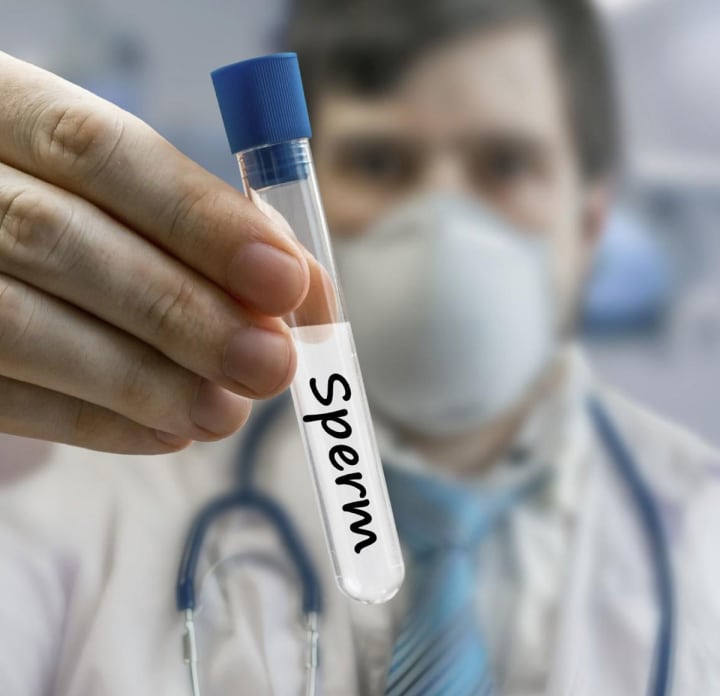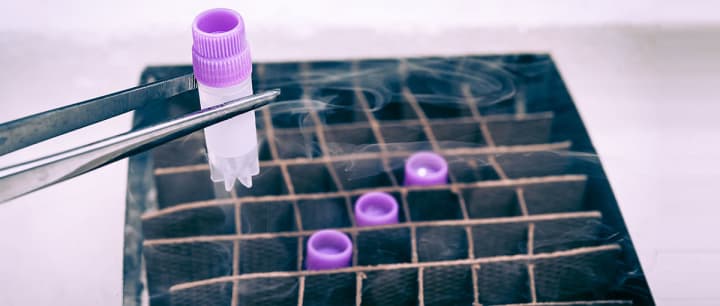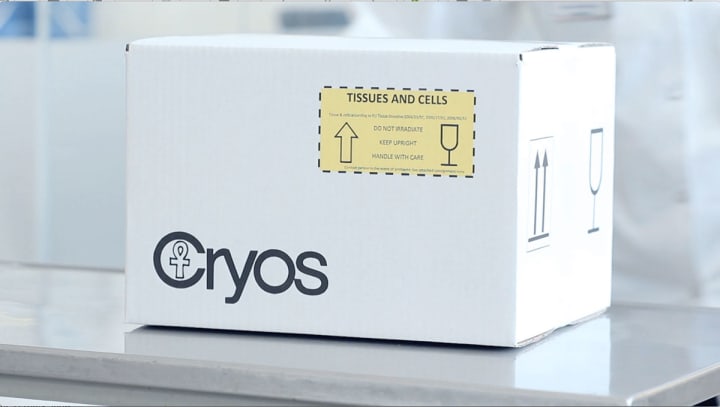Sperm Bank Guide
The big spurt in sperm banks may eventually become a strictly mail order service.

A tall, good-looking man in a Tom Ford suit walks through the revolving door of a nondescript brick building in the heart of a small bustling city. The receptionist behind the counter looks up from her appointment calendar.
"I’ve got to meet a client in 30 minutes," says the man, checking his watch.
"Fine," the woman answers. "Let’s get to it."
The receptionist leads him down the hallway and opens the door to one of several small cubicles. She doesn’t say much; She doesn't have to. He has been coming here at least once a week for almost five months, and he knows the procedure as well as she does.
As they enter the tiny room, she hands him a glass jar about the size of a coffee container. He thanks her and closes the door. Outside, she pulls a latch changing a sign on the door from VACANT to OCCUPIED, like on an airplane lavatory.
The cubicle itself is sparse, furnished only with a chair, a cot, a sink, a box of Kleenex, and a rack of erotic magazines. The man removes his suit pants and jacket, folds them with care, and places them on the chair. Next he takes off his underpants, hikes his shirt up, and lies back on the cot with the latest copy of Penthouse. He flips through the magazine, finally settling on a pictorial featuring two beautiful women making love at the seashore. Enjoying the images, he sighs deeply, closes his eyes and jerks off into the glass container.
As the man dresses to leave, the receptionist writes a check for $25. It may not be a fortune, he thinks as she hands it to him, but there are a helluva lot worse ways to pick up lunch money.
This man has just visited a sperm bank, which is basically a storage facility for human semen. Sperm banks—or "cryobanks" (cryo refers to the freezing of solutions for medical purposes) represent an increasingly popular way of impregnating women who want babies but don't have fertile partners. These may include lesbians, women whose husbands have some hereditary disease, or those without any partners at all. Many of the banks are affiliated with a medical center that performs artificial insemination—a procedure in which the thawed sperm is injected into a recipient's vagina.
Through the use of detailed catalogs, these facilities attempt to match donors with female recipients who might be looking for particular characteristics in a father to pass on to their children—such as height, intelligence, eye color, or even a history of professional success. Because of that function, some critics charge that sperm banks promise more than they can deliver. Others question the morality of "choosing" a baby to match a parent's preconceived notions. Still others see in cryobanks a chilling parallel with Hitler's attempt to create a master race.

Photo via One How To
Numbers and Figures
As is evident, sperm banks didn't take long to arouse controversy. Idant Laboratories of New York, the nation's largest, has been in business since 1971. But most of the other entries in the field—especially on the West Coast, where sperm banks are spreading rapidly—have been operating for less time. The American Association of Tissue Banks (AATB)—a national organization that monitors donations of everything from kidneys to sperm—has an incomplete list of cryobanks that voluntarily report inseminations attempted under clinical conditions. The actual number of sperm banks is thought to be much larger than the number listed in AATB, however, because none of the facilities are required to report their activities to anyone. In California, for instance, just a third of the known cryobanks report to the AATB, the only "consumer guide" to sperm banks that potential customers have.
"We don't know the number of cryobanks that are out there in various stages of reputable activity," says Jerome Sherman of the AATB. "Many banks are very active. Some are good; Others aren't. We don't know anything about them."
It is known that sperm banks figure in a large portion of the artificial inseminations attempted yearly. The number of live births resulting from those attempts is less certain—partly because so few banks report their results, partly because not all women notify the bank once conception or birth occurs.
But Idant Labs—known variously as the "Chase Manhattan of cryobanks" or the "Sultan of Seed"—has itself been responsible for nearly 11,000 documented pregnancies. Refrigerated in liquid nitrogen, tiny vials of Idant sperm are always on the road to some destination. The company maintains its position as the nation's leading sperm bank. It also holds the world record for a successful pregnancy resulting in a live birth from sperm that was stored for 29 years.
While Idant dwarfs the competition nationally, sperm banks are booming from coast to coast. According to a sperm banker of the Southern California Cryobank in Los Angeles (another of America's largest sperm depositories), his business has grown tremendously since opening its doors in 1977, boasting 25 million motile sperm per milliliter. This sperm banker is one of a handful who admit to entering the field solely to make a profit.

Photo via Invitra
Benefits of Banking
Sperm banks first began to spring up when vasectomies became fashionable early in the swinging 70s. Some men contemplating the sterilization operation would first store their sperm in case they later got divorced, remarried, or decided for any other reason to leave open the option of future parenthood. Nowadays, says a former director of the Valley Cryobank in Encino, California, "we’re storing sperm for people undergoing radiation therapy for cancer or even for those whose jobs bring them into contact with hazardous chemicals." Additionally, people are having children later in life while they focus on securing a good education and a better job.
The doctor explains that since radiation and certain chemicals have been shown to damage sperm cells, it makes sense to store healthy semen before undergoing such exposure. Idant Labs, in fact, did nothing but store sperm for men in such situations during its first three years. In 1974, the company noticed growing public interest in the use of such sperm to impregnate women without fertile partners. Today, a mammoth donor-insemination program provides Idant with 90 percent of its annual revenues.
For the actual insemination process, women pay anywhere between $300 up to $2,000. The cost of the sperm, of course, is extra.
"It means so much to the women who come to us," says one doctor, whose cryobank is equipped to handle the whole process from ejaculation to birth. "Time after time, mothers bring the babies around for us to see. It's very rewarding."

Photo via Invitra
Choosing Sperm Donors
Following health screening and approval, the donors are catalogued in a brochure describing sperm donors by age, race, religion, height, weight, coloring, and other traits that might interest prospective parents. As at all sperm banks, the donor's name is withheld. Virtually all of today's work from such a catalog.
Typically, women are given a choice of several donors who conform to a profile requested beforehand. "If the woman is married," says a doctor from the Valley Cryobank, "the idea is really to match the donor's physical characteristics to those of the husband. That way, at least in terms of appearance, it would seem possible for the husband to be the baby's father."
The Oakland center's catalog reflects the diversity of races and lifestyles found in the San Francisco Bay Area. Many of those who join the insemination program, for example, are interracial couples—much higher than the ratio nationally. These people come to the center in search of a specific genetic ancestry for their child. Rather than gamble on having a baby of their own who might turn out to be black, white, or something in between, they choose a donor matching either the father's or the mother's race.
Other clients of the facility include lesbian partners and a large number of couples enrolled in the center's co-parenting program. In the latter category are single men and women who’ve decided to "share" a baby in the absence of marriage or sex.
Most of Oakland's remaining clients are single women who've finally decided to have a baby after choosing earlier in their lives to pursue careers instead. "A lot of single women we see are people who haven’t met the man of their dreams yet, but now they're at the stage in their life where they want the nurturing experience," another doctor explains. The average age of women in Oakland's program is 34; Half are even older.

Photo via Orlando Sentinel
Future of Sperm Banks
Many sperm banks are adjusting to the future of technology and opting for mail-in sperm donations. Cryogenic Laboratories offers Priority Male banking, a unique and effective way for men to collect and send their semen to Fairfax Cryobank from anywhere in the US. This option is not for sperm donation, but instead for preservation for a later time. The FDA has determined that this type of sperm collection via mail is only to be used with an identified sexually intimate partner.
The Priority Male Kit includes everything you need to send in your sperm specimen, such as detailed instructions, the necessary forms, a collection container, and a pre-paid shipping packaging for overnight delivery.
Once the sperm is received at the facility, a semen analysis is performed by the knowledgeable technicians. This analysis figures out the number of sperm in the sample, as well as the activity and shape of the sperm. All of this helps to determine the vitality of the sperm. Based on all of this information, the specimen is divided into several vials and then frozen for preservation. This way of preserving sperm may eventually be the preferred and regulated way to also donate sperm for use by others.
About the Creator
Filthy Staff
A group of inappropriate, unconventional & disruptive professionals. Some are women, some are men, some are straight, some are gay. All are Filthy.






Comments
There are no comments for this story
Be the first to respond and start the conversation.